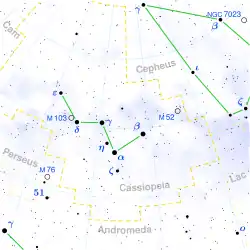ظهر الناقة (نجم)
أو إيتا ذات الكرسي Eta Cassiopeiae اسمه التقليدي Achird مشتق من الاسم العربي. وهو نظام نجمي في كوكبة ذات الكرسي. ويبعد 19.4 سنة ضوئية عن الأرض.
| ظهر الناقة | |
|---|---|
 ظهر الناقة يسار صدر ذات الكرسي | |
| معلومات الرصد حقبة J2000 اعتدالان J2000 | |
| كوكبة | ذات الكرسي |
| مطلع مستقيم | 00س 49د 06.29070ث[1] |
| الميل | ° +57 ′48 ″54.6758[1] |
| القدر الظاهري (V) | 3.44[2]/7.51[3] |
| الخصائص | |
| نوع الطيف | G0 V[4] + K7 V[3] |
| U−B مؤشر اللون | +0.02[2]/1.03 |
| B−V مؤشر اللون | +0.58[2]/1.39 |
| نوع التغير | RS CVn?[5] |
| القياسات الفلكية | |
| السرعة الشعاعية (Rv) | +10.0 ± 0.1[6] كم/ث |
| الحركة الخاصة (μ) | 1086.59[1]–559.43[1] |
| التزيح (π) | 167.98 ± 0.48 د.ق |
| البعد | 19٫42 ± 0٫06 س.ض (5٫95 ± 0٫02 ف.ف) |
| المدار | |
| مرافق | Eta Cassiopeiae B |
| الدورة (P) | 480 |
| نصف المحور الرئيسي (a) | 11.9939" |
| الشذوذ المداري (e) | 0.497 |
| زاوية الميلان (i) | 34.76° |
| زاوية العقدة المدارية (Ω) | 98.42° |
| القبا عصر (T) | 1889.6 |
| البعد الزاوي الحضيضي (ω) (ثانوي) |
88.59° |
| تفاصيل | |
| η Cas A | |
| كتلة | 0.972 ± 0.012[7] ك☉ |
| نصف قطر | 1.0386 ± 0.0038[8] نق☉ |
| ضياء | 1.2321 ± 0.0074[8] ض☉ |
| درجة الحرارة | 5973 ± 8[8] ك |
| معدنية (فلك) [Fe/H] | –0.31[3] dex |
| سرعة الدوران (v sin i) | 3.15[4] كم/ثا |
| عمر | 5.4 ± 0.9[7] ج.سنة |
| η Cas B | |
| كتلة | 0.57 ± 0.07[3] ك☉ |
| نصف قطر | 0.66[9] نق☉ |
| ضياء | 0.06[3] ض☉ |
| درجة الحرارة | 4036 ± 150[3] ك |
| تسميات اخرى | |
| Achird, تسمية باير 24 Cassiopeiae, فهرس النجوم 671, مسح بون الفلكي+57°150, فهرس النجوم 155, فهرس غليس للنجوم القريبة 34, فهرس هنري درابر 4614, هيباركوس 3821, فهرس النجم الساطع 219, فهرس النجوم 123/122, فهرس النجوم 74, فهرس النجوم 10287, فهرس مرصد سميثسونيان للفيزياء الفلكية 21732, Wolf 24, Struve 60, GC 962, CCDM J00491+5749.[6] | |
| قاعدة بيانات المراجع | |
| سيمباد | The system A B |
النجم الرئيسي هو نسق أساسي أصفر ينتمي إلى الفئة الطيفية G0V مما يجعله يقع في نفس التصنيف مع الشمس والتي تنتمي إلى الفئة الطيفية G2V والقدر الظاهري له 3.45+ . أما رفيق هذا النجم فهو أبرد وأكثر عتمة بقدر ظاهري 7.51 وهو قزم برتقالي ينتمي إلى الفئة الطيفية K7V.[10] ويعتبر النظام النجمي متغير بحيث يتغير قدره بمقدار 0.05
معرض صور
انظر أيضا
المراجع
- van Leeuwen, F. (November 2007), "Validation of the new Hipparcos reduction", Astronomy and Astrophysics, 474 (2): 653–664, arXiv:0708.1752, Bibcode:2007A&A...474..653V, doi:10.1051/0004-6361:20078357 الوسيط
|CitationClass=تم تجاهله (مساعدة); الوسيط|separator=تم تجاهله (مساعدة)CS1 maint: ref=harv (link) - Johnson, H. L.; et al. (1966), "UBVRIJKL photometry of the bright stars", Communications of the Lunar and Planetary Laboratory, 4 (99), Bibcode:1966CoLPL...4...99J الوسيط
|CitationClass=تم تجاهله (مساعدة); الوسيط|separator=تم تجاهله (مساعدة)CS1 maint: ref=harv (link) - Fernandes, J.; et al. (1998), "Fundamental stellar parameters for nearby visual binary stars: eta Cas, XI Boo, 70 OPH and 85 Peg", Astronomy and Astrophysics, 338: 455–464, Bibcode:1998A&A...338..455F الوسيط
|CitationClass=تم تجاهله (مساعدة); الوسيط|separator=تم تجاهله (مساعدة)CS1 maint: ref=harv (link) - Martínez-Arnáiz, R.; et al. (September 2010), "Chromospheric activity and rotation of FGK stars in the solar vicinity. An estimation of the radial velocity jitter", Astronomy and Astrophysics, 520: A79, arXiv:1002.4391, Bibcode:2010A&A...520A..79M, doi:10.1051/0004-6361/200913725 الوسيط
|CitationClass=تم تجاهله (مساعدة); الوسيط|separator=تم تجاهله (مساعدة)CS1 maint: ref=harv (link) - Samus, N. N.; Durlevich, O. V.; et al. (2009). "VizieR Online Data Catalog: General Catalogue of Variable Stars (Samus+ 2007-2013)". VizieR On-line Data Catalog: B/gcvs. Originally published in: 2009yCat....102025S. 1. Bibcode:2009yCat....102025S. الوسيط
|CitationClass=تم تجاهله (مساعدة) - "eta Cas -- Spectroscopic binary", Simbad Astronomical Object Database, Centre de Données astronomiques de Strasbourg, مؤرشف من الأصل في 10 ديسمبر 2019, اطلع عليه بتاريخ 10 أبريل 2008 الوسيط
|CitationClass=تم تجاهله (مساعدة); الوسيط|separator=تم تجاهله (مساعدة)CS1 maint: ref=harv (link) - Boyajian, Tabetha S.; et al. (February 2012), "Stellar Diameters and Temperatures. I. Main-sequence A, F, and G Stars", The Astrophysical Journal, 746 (1): 101, arXiv:1112.3316, Bibcode:2012ApJ...746..101B, doi:10.1088/0004-637X/746/1/101 الوسيط
|CitationClass=تم تجاهله (مساعدة); الوسيط|separator=تم تجاهله (مساعدة)CS1 maint: ref=harv (link) - Boyajian, Tabetha S.; et al. (July 2013), "Stellar Diameters and Temperatures. III. Main-sequence A, F, G, and K Stars: Additional High-precision Measurements and Empirical Relations", The Astrophysical Journal, 771 (1): 40, arXiv:1306.2974, Bibcode:2013ApJ...771...40B, doi:10.1088/0004-637X/771/1/40 الوسيط
|CitationClass=تم تجاهله (مساعدة); الوسيط|separator=تم تجاهله (مساعدة)CS1 maint: ref=harv (link) - Johnson, H. M.; Wright, C. D. (1983), "Predicted infrared brightness of stars within 25 parsecs of the sun", Astrophysical Journal Supplement Series, 53: 643–711, Bibcode:1983ApJS...53..643J, doi:10.1086/190905 الوسيط
|CitationClass=تم تجاهله (مساعدة); الوسيط|separator=تم تجاهله (مساعدة)CS1 maint: ref=harv (link)—see p. 647. - V* eta Cas نسخة محفوظة 7 نوفمبر 2017 على موقع واي باك مشين.
}}
- بوابة نجوم
- بوابة علم الفلك
This article is issued from Wikipedia. The text is licensed under Creative Commons - Attribution - Sharealike. Additional terms may apply for the media files.


